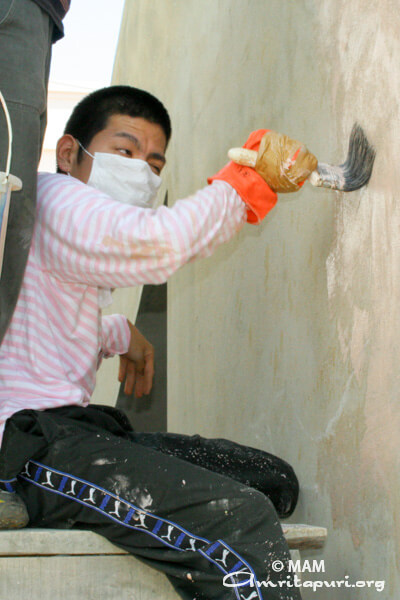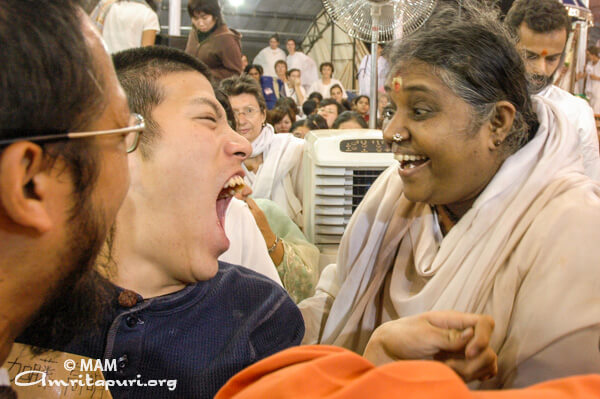6 March 2006 — Pandagasalai Village, Nagapattinam District, Tamil Nadu

For the seventh time since 1998, members of Japan’s International Volunteer University Student Association (IVUSA {news}) are participating in the Amrita Kuteeram house-building project. This year more than 80 such students have traveled to Nagapattinam to help build tsunami-relief housing in the villages of Pandagasalai, Akkarapettai and Mele Pattinacherry.
There are many familiar faces in this year’s group, as many students have participated two or three years in a row. But there is one new face in the crowd that is hard to overlook.
Due to birth complications, 22-year-old Taka Aki was afflicted with a severe case of cerebral paralysis. Intellectually he is just like any other university student, but he has very limited control over his muscles and is thus constrained to a wheelchair and has difficulty even speaking.
Taka Aki has longed to participate in Amrita Kuteeram since first meeting Amma in Tokyo in 2003. He has come to see Amma in Tokyo every year since and has been active with IVUSA throughout the year. But due to his condition, traveling to India always seemed unrealistic to him. In hi-tech Tokyo, he moves about freely using a motorized wheelchair and communicates via computer. But if he came to India he knew he would have to leave these supports behind, and he did not want to be a burden for others. For two years, Taka Aki told himself that traveling to India was simply not in the cards. However when faced with the fact that this year would be his last at the university, he decided he had to try.

This year, the students’ flight from Japan arrived in Mumbai on the night of Amma’s program at Shivaji Park {news}. They all thus we able to have Amma’s darshan before traveling on to Nagapattinam. When Taka Aki was carried up to Amma for his darshan, Amma was both surprised and delighted to see him.
The first day in Nagapattinam was no different than any other at a construction site in India—extremely hot with lots of heavy manual labor. There was nothing that Taka Aki could do. His wheelchair even got a flat tire and he had to be pushed and carried along the dirt roads and over the thorny bushes. He simply sat in the shade, watching everyone else and longing for an opportunity to serve.
Then the next day someone suggested that maybe he could paint. He was thrilled by the idea and immediately agreed to try. Soon, a few people carried him onto a scaffolding, taped a paintbrush in his hand (he is unable to grip things), and he was ready to go. Someone guided his hand into the paint bucket and then, with great effort, he moved the brush back and forth along the wall. Paint was flying everywhere, spraying anyone within range, but no one seemed to mind or even moved out of the way. The scene was too inspiring to leave. A small crowd began to gather, and tears came to many people’s eyes. One of the site supervisors was visibly touched and, with his hands over his heart, said, ‘This is real service.’
Taka Aki spent the next several hours painting. Every so often the scaffolding would be shifted so that he could reach another section, and different people took turns supporting him on the scaffolding and helping him to dip his brush. Throughout the day the other students continually shouted encouragement, some joking with love that he had painted himself as much as the house.
By the time the sun began to set, the house had been transformed from the lifeless gray of cement to the inspiring pink of the horizon.
–Dass
